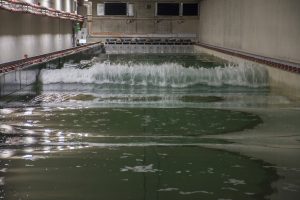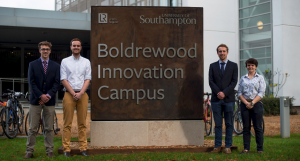Research has recently been undertaken utilising the new 138m towing tank at the University of Southampton. Funded by the Higher Education Innovation Fund (HEIF) via the Southampton Marine and Maritime Institute (SMMI), the research is a collaboration between Dr Sally Bennett (Fluid-Structure Interactions) and Prof. Robert Marsh (Ocean and Earth Sciences) which looks at the characterisation of freak wave groups for safer ship routing. The research strongly links with PhD research being undertaken by Alex Cattrell within the Fluid-Structure Interactions group at University of Southampton.
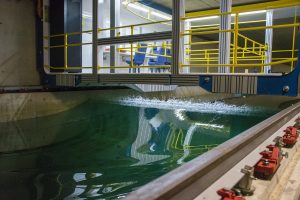
The recent testing focussed on the characterisation of freak waves and freak wave groups in terms of their formation and shape. Waves were generated at a scale of 1:22. A combination of photography, video imagery and state-of-the-art ultrasonic wave probe technology was used to analyse the wave formation including breaking wave characteristics where appropriate. A video of some of the testing can be found at https://youtu.be/EQ05QXMoShg.
Following this investigation into the wave groups themselves, this project will continue by looking at the influence of these waves on a ship, and how to manoeuvre the vessel through the waves to minimise structural loading, and therefore damage.
GDP 2 – Autonomous Hull cleaning Robot
Last but not least of our series introducing this years Group Design Projects run from the ship science programme. The project aims to solve many problems that hull fouling causes, both environmentally and financially. To name a few:
- 39% of invasive species transported by shipping are found in the hull fouling (Molnar et al., 2008)
- A fouled hull leads to increased fuel consumption and carbon emissions (M.P. Schultz, 2010)
- Existing cleaning methods require the ship to remain in port
We are undertaking the design build and test of an autonomous hull cleaning robot, capable of regularly cleaning the hull of a ship while the ship is at operational speeds.
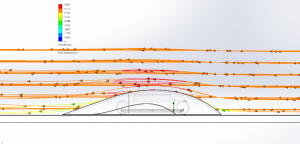
To achieve this we are going to:
- Develop an attachment method capable of resisting the forces the robot is subject to at operational ship speeds.
- Develop the autonomous system which is able to navigate a defined area, maintaining knowledge of its position within the domain and avoiding obstacles.
- Design and test a body form which is optimised to aid the attachment method
- Manufacture the various elements of the robot to be tested individually
- Test the ability of the final assembly to perform under simulated operating conditions
Unsteady fluid Interaction effects on riser clusters -FSI Seminar 10th Dec
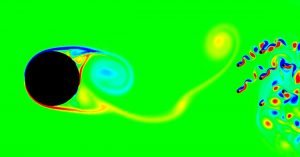 FSI Seminar on Thursday 10th December in 176/L1107,
FSI Seminar on Thursday 10th December in 176/L1107,
Boldrewood Innovation Campus
to be given by Christian Klettner, Research associate, Mechanical Engineering, University College London
Risers from the sea floor to installations at the sea surface are an integral part of the flow assurance of deep sea oil exploration, which has become necessary in the last decade. These risers are subjected to various hydrodynamic forcing, particularly sea currents, wakes of upstream installation members and surface waves, which can result in vortex or wake induced vibrations and these in turn can result in riser fatigue or collision. The free stream flow past groups of cylinders has been studied for two- and three-dimensions for Re=100(based on the cylinder diameter) by Nicolle & Eames (2011) (direct numerical simulations) and ReO(10000) by Chang \& Constantinescu (2015) (large eddy simulations) respectively. In this study we will be focusing on the first two aspects listed above, numerical simulations will be performed to investigate the effect of an upstream truss on an array of cylinders. The main diagnostic will be how varying the void fraction of the array of cylinders affects the frequency and magnitude of the drag and lift forces on the cylinders.
Brief CV
Christian Klettner received his BEng in 2006 and PhD in 2010 from University College London. His PhD, under the supervision of Ian Eames, was on aspects of solitary waves propagating over different topography using numerical simulations. He was in at National University Hospital Singapore as a post doc for 2.5 years developing numerical models and performing small scale experiments on transport in hospital rooms. He is now a post doc at UCL Department of Mechanical Engineering working on the project URBANWAVES which is in collaboration with UCL Civil Engineering Department. The project will investigate the forces exerted on coastal installations during tsunami and storm surge inundation which will require the development of various numerical methods. The intention is to calibrate a shallow water model with large scale numerical simulations of the flow past a building with varying blockage ratio. These can then be incorporated into city wide shallow water models.
Ships Science students visit Arcadia and Queen Victoria
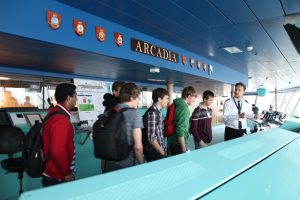
Part 1 ship science students were given special tours around the P & O Cruise ship MV Arcadia and Carnival Cruise ship MV Queen Victoria, when they were docked simultaneously recently in Southampton port.
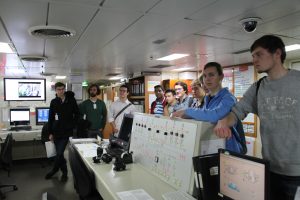
During the turnaround on that day of both ships the ships’ crew gave the group of ten students in each case a wide ranging tour of the ship. This included in particular the engine control room, main engine room, podded propulsion area and the bridge, which helped the groups understand how really big ships work.
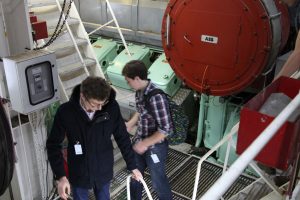
As the group moved around the ship public spaces were examined as were the access between different decks. The scale of ship was brought home by the constant movement of stores along the main access area for stores, luggage and crew. The ship’s crew were extremely helpful in answering a whole plethora of technical questions. Prof Philip Wilson accompanied the group on the Arcadia and Dr Jon Downes accompanied the group on the Queen Victoria.
Next week a group of 20 Part 1 ship science students will tour around the MV Ventura when she is in Southampton port.
https://en.wikipedia.org/wiki/MV_Arcadia_(2004)
https://en.wikipedia.org/wiki/MS_Queen_Victoria
Delphin2 Trials continue at Eastleigh Lakes
Delphin 2 has been the subject of a series of experiments in the Boldrewood Towing Tank but last week the emphasis was to have spiral manoeuvring trails in the Eastleigh lakes. So Kantapon and Sophia the two doctoral students who are using Delphin 2 for their research together with Prof Wilson transported Delphin 2 to the Eastleigh lakes.
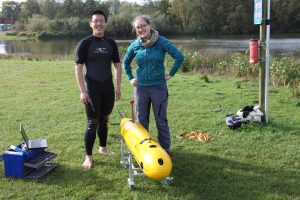
At this time of the year the weather plays an important role, but in the morning we had nearly flat calm conditions as well as sun, so we were able to set up and get the tests started promptly.
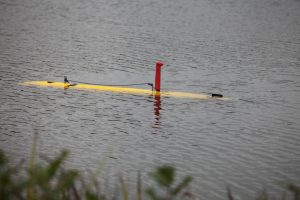
Light stopped play at 3pm. The tests were a success and we certainly achieved a great deal of outreach since there were a constant flow of people asking what were we doing.
Work on Delphin2 has been ongoing over a number of years and is part of the activities of the maritime robotics laboratory and is in collaboration with Drs Phillips and Furlong at the National Oceanography Centre, Southampton.
GDP81 Wingsail for Southampton Hydro-Aero Research Catamaran
We are working on a project to fit a wing sail and set of hydrofoils to an F18 catamaran, called SHARC (Southampton Hydro-Aero Research Catamaran). The aim would be to create a wing sail and foil system that can then be rescaled to attach other types of dinghy and be easily broken down for easy travelling.
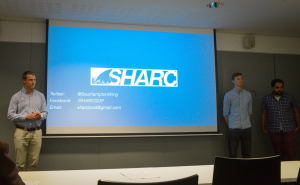
The project is the culmination of our four year degree in Naval Architecture/Maritime Engineering and will result in the finished boat being sailed in April. We hope that the project will provide a platform for testing new hydrofoil and wing sail systems that will be developed over the coming years by the university.
The wing sail which is being built for the project will be similarly shaped to those already being used by Americas Cup teams and the C-Class catamarans. We are going to have a leading and trailing flap, which will have a controllable camber, and then a top section that can be twisted off in heavier winds. The major problem with a wing sail is making the rig light enough to be able to not adversely affect the performance of the boat, and so lightweight and strong rigging will be crucial to the success of the project. We are fortunate to have the support of Forward WIP who will ensure that the sailors are properly fitted out so that they are as safe as possible during testing, their range can be found here: http://www.forward-wip.com/
We hope to begin building in January, and will be sailing the wing in March next year. Find us on Facebook to stay up to date with all of the developments! Facebook: /SHARCGDP
GDP63 Team Fortitude – Autonomous Operations at Sea
Team Fortitude has now become a group of nine finalists (six ship scientists and three mechanical engineers) who aim to show proof of concept for a number of autonomous solutions applicable to full scale ships using last year’s autonomous surface vessel (ASV), Fortitude.

In 2013, 54 ships were lost at sea, sank or were never found and it’s recognised that around 80% of marine accidents involve some aspect of human error. The Team wants to explore how the number of casualties at sea could be reduced by enhancing automation to aid human part of operation from ships. Beyond the safety concerns, up to 40% of a ship’s operating costs are associated with crewing. The hours can be long and with significant time spent away from home. If you can alter the responsibilities and hours and potentially base more of the crew in shore based roles you can improve working conditions and reduce some of this cost. Team Fortitude wants to prove the feasibility of autonomous ships by showing how a number of autonomous solutions can approach day to day operational requirements on a vessel (e.g. navigational decision making, diagnostics communications, tank operations and fluid movements etc.). These solutions will be scaled down and applied to the current Fortitude platform to investigate these issues.
By the end of the academic year the Team hope to test the ASV with a fully autonomous journey around the Isle of Wight. Under current constraints this is a totally feasible objective and will not pose any threat to Fortitude as the trip can be supervised. Under additional support the Team will be able to further their improvements to set Fortitude up for a transatlantic crossing. The journey has never been done by an ASV and it would be a fantastic opportunity for the University to make the very most of. The trip would take around 40 days and would truly push the longevity of autonomous parts, a fact that would be absolutely vital for a fully autonomous ship.
To stay up to date with Team Fortitude, head to www.facebook.com/fortitudeASV and/or www.twitter.com/fortitudeASV or to get in touch email fdt@soton.ac.uk.
GDP57 HydroStructural Approach to a Hydrofoiling Wing Sail Powered Research Platform
We will be supplying updates on our four ship science group design projects during the year. These projects are relatively unique within UK Maritime courses in their experience for final year students in actually building and testing and getting essential real world experience .
Modern racing boats don’t just sail, they fly. With the technological advancements of the America’s Cup over the past 5 years the sport of sailing is beginning to transition from an old man’s activity to F1 on water. The America’s Cup has turned into a fast paced spectator sport with short races packed with tight manoeuvres and speeds in excess of 30 knots. The Southampton Hydro Aero Research Catamaran (SHARC) looks to bring this thrill of foiling to the general sailing community as well as providing a research platform for use by the University.
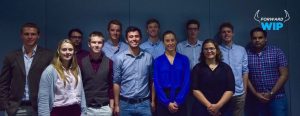
Over the next six months our team will be designing and manufacturing three key components that will allow us to convert a 2004 Nacra F18 into a Hydrofoiling machine. The first component will be the hydrofoils themselves. Design work has already begun and we have been using Computational Fluid Dynamics to determine the lift and drag associated with different designs, this will ensure that our foils will be able to lift the boat out of the water. The second component is an adaptable pod system for housing the foils. This key element once built will allow us to attach our foils to not just our F18 but to any small catamaran. This will enable anyone with a small catamaran to experience foiling. The design surrounding this pod will have to do a great deal of research into the forces surrounding it to ensure the materials and structure will not fail. The final aspect of our project will be the installation of a data acquisition system that will allow researchers and sailors to analyse the performance of the boat. This will involve laying up strain gauges within the foils and pods to allow us to observe effects such as tip deflection while sailing. This sort of information will be fed back to a central data logger which will then store data as well as feed it wirelessly to a laptop for live performance feedback.
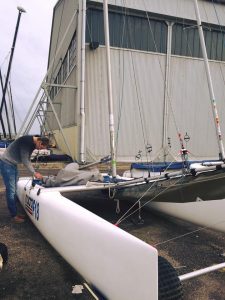
With this project we look to inspire more of the sailing community to experience hydrofoiling as well as nurturing their interest in STEM subjects. By providing the University with a functional hydrofoiling research platform further studies can be undertaken to advance hydrofoiling design and technology for use throughout the sailing community and within the America’s Cup.
Follow our project on facebook: https://www.facebook.com/SHARCGDP/?fref=ts
Women in Science and Engineering
Free biscuits was a big draw for the recent Ada Lovelace day events hosted by FSI in the café in B176. This was one of many events on campus encouraging staff and students to promote opportunities in STEM subjects and challenge traditional attitudes.
Ada Lovelace Day is an international celebration of the achievements of women in science, technology, engineering and maths (STEM).
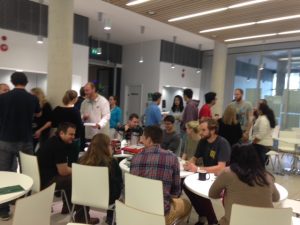
The University-wide Women in Science, Engineering and Technology (WiSET) group is working on a massive challenge to celebrate the women in our STEM subjects by trying encourage ALL our staff (men and women!) to stop for five minutes and have a biscuit break!
Visit of Assembly of European Regions
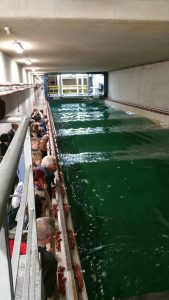
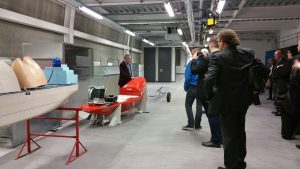
 As part of their Autumn plenary hosted by Hampshire County Council delegates to the Assembly of European Regions recently visited the Boldrewood Innovation Campus. FSI staff and students conducted a series of demonstrations of the new towing tank, tours of the laboratories including the maritime robotics as well as the Autonomy command and control vans. Feedback from the delegates was very positive – they were impressed with the campus as a whole and the close cooperation of LR and the University in developing the facilities.
As part of their Autumn plenary hosted by Hampshire County Council delegates to the Assembly of European Regions recently visited the Boldrewood Innovation Campus. FSI staff and students conducted a series of demonstrations of the new towing tank, tours of the laboratories including the maritime robotics as well as the Autonomy command and control vans. Feedback from the delegates was very positive – they were impressed with the campus as a whole and the close cooperation of LR and the University in developing the facilities.

